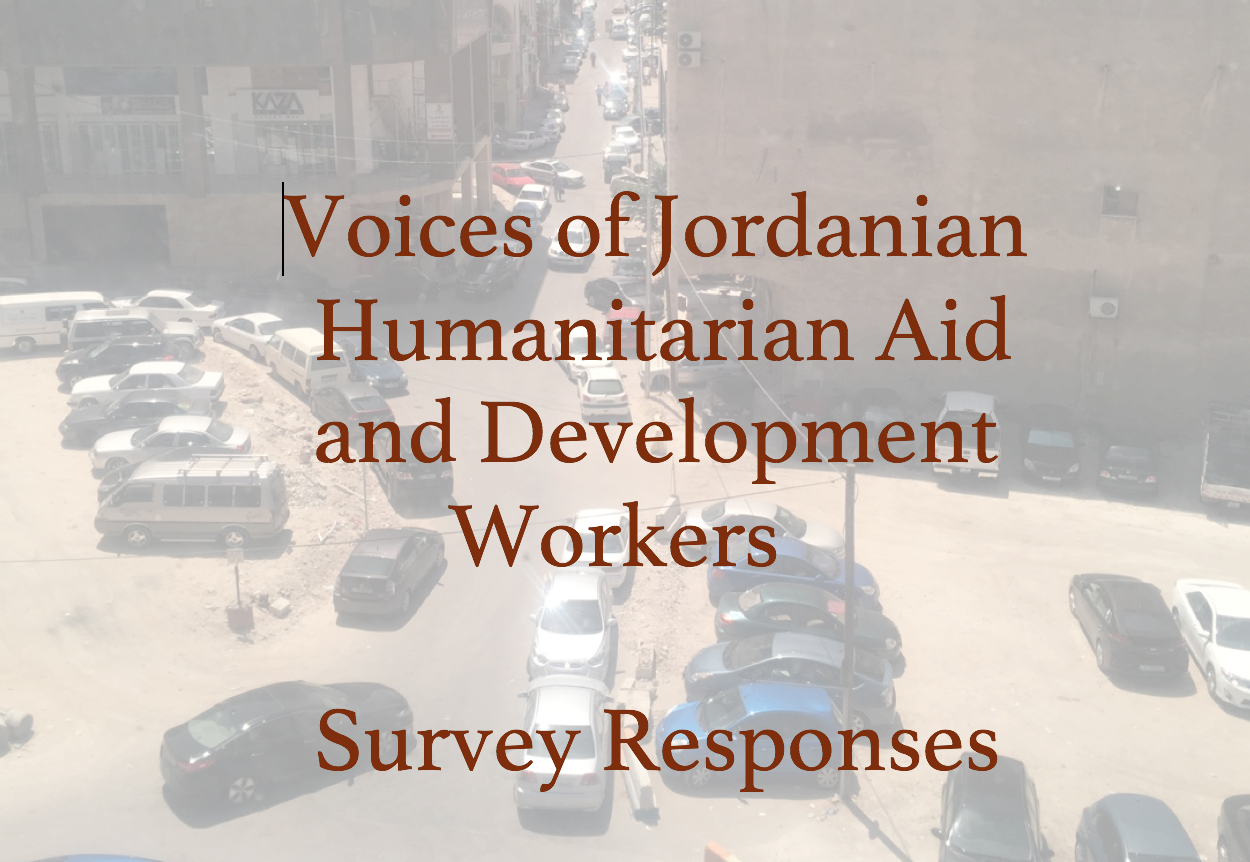The gap between donor interests and the needs of the affected community
More results from the Jordanian humanitarian worker survey.
A frustrating gap
Although I have heard and read a good deal about the general frustration in the humanitarian aid sector about the gap between donor interests and the needs of the affected community, it was not until my travel to Amman and the chance to talk face to face with several Jordanian aid workers did I come to more deeply understand this issue. In several interviews I asked the open ended question “What are some of your frustrations?” and the donor interest-affected community needs gap was very near the top of everyone’s lists.
 If you Google search the ‘three legged stool’ trope you’ll find a multitude of references dealing with all kinds of organizations, industries and businesses. My colleague ‘J’ has written about this as it relates to the aid sector, pointing out, accurately in my opinion, that the sector can be distilled down into three parts, namely the donors, the recipients, and those people and organizations that comprise the humanitarian aid sector.
If you Google search the ‘three legged stool’ trope you’ll find a multitude of references dealing with all kinds of organizations, industries and businesses. My colleague ‘J’ has written about this as it relates to the aid sector, pointing out, accurately in my opinion, that the sector can be distilled down into three parts, namely the donors, the recipients, and those people and organizations that comprise the humanitarian aid sector.
Understanding the organizational, bureaucratic, political, and cultural (including linguistic) complexities of the interactions between these three basic units is a massive task, made all the more difficult by the fact that rarely are two humanitarian responses exactly alike. One constant is the fact that global, regional, and local geopolitical realities will come into play, and these realities are, to say the least, fluid; the cocktail of political factors impacting any one geographic region are rarely simple or static.

All to say this: pointing out there is a gap between donor interests and the needs of the affected community is akin to observing that ‘water runs downhill.’ We do not live in a perfect, linear, and orderly world, and that gaps such as this exist, though frustrating, are typical. The width of the gap varies considerably from one scenario to the next. Minimizing the gap is a meaningful goal, hard to measure progress and even harder to reach to the extent that everyone feel pleased.
Having preliminary data showing that aid workers perceive that gap and are frustrated by it is one step toward meaningfully addressing the situation.
Who should ‘mind the gap’? A comment on imperfections in the humanitarian sector
 There is a persistent, chronic, and perhaps inexorable disconnect between the lofty ideas and goals being imagined by academics and ‘experts’ in humanitarian think tanks and what policy changes and organizational adaptations can and are actually being implemented in most sectors. This disconnect includes an array of issues. Here are just a few:
There is a persistent, chronic, and perhaps inexorable disconnect between the lofty ideas and goals being imagined by academics and ‘experts’ in humanitarian think tanks and what policy changes and organizational adaptations can and are actually being implemented in most sectors. This disconnect includes an array of issues. Here are just a few:
- ‘zero-tolerance’ of sex related misbehavior
- the ‘localization’ of the sector
- the issues related to the relationships between ‘international’ and ‘local’ workers
- how best to maintain the safely and security of humanitarian workers
- how to manage the slippery slope from aid to development
and, of course
- the gap between donor interests and the needs of the affected communities
Addressing issues within the sector is done on many levels at both the inter and intra organizational levels. And though there indeed are ‘disconnects’, I’ll offer the observation that the good being done by the sector is massive and, by some critics at times, under appreciated. Every day countless refugees and IDP’s are being supported in hundreds of camps globally. Shelter, food, sanitation, security, and social support are being provided to millions of people day in and day out. Innumerable surgeries are performed, medical procedures administered, medicines dispensed, babies delivered, and psychosocial support provided every day in countless venues around the world. All of this is being done by organizations that employ a rich mix of international, national, and local humanitarian aid workers, all working together -the vast majority of the time- for exactly the same goal, to address and minimize the human impact of natural and human-made disasters.
Band-aides (plasters) are put over wounds and, yes, the system is imperfect. But to dwell on that imperfection without acknowledging the massive positive outcomes is counterproductive on many levels.
On to the data
I asked two interrelated questions. “In general, to what extent do you see a gap between donor interests and the needs of the affected communities?” and “How does the gap between donor interests and the needs of the affected communities impact your work and motivation?” In summary, the results indicate that well over half (55%) of the respondents ‘frequently’ or ‘constantly’ see a ‘gap between donor interests and the needs of the affected communities’ and the vast majority -83%- are ‘somewhat’ or ‘very’ frustrated by these gaps.
Comment
This statement by one of the respondents on the survey summarizes what I heard in one on one interviews with several Jordanian humanitarian workers.
“Donors ask for high targets and they don’t pay much attention to quality implementation, which is very frustrating. I have seen many INGOs fake numbers to please donors. This turns beneficiaires to numbers instead of people!”
In a previous post I wrote in detail about the chronic issue of ‘turning people into numbers’, quoting from an international aid worker, Lily Rosen. Her poetry and prose help us to better understand some of the inherent difficulties in bridging gaps between “how things are and how we say things are”.
Another respondent offered this suggestion,
“Humanitarian and development agencies need to play a major role in changing donor strategies which are sometimes restrictive and lacks a certain needed creativity, especially in the development sector while paying more attention to the actual needs of the effected communities.”
That Jordanian aid workers see and are frustrated by the gap between donor interests and the needs of the affected community is a surprise to no one. The data above, I hope, can serve as a starting point for deeper inquiry into this issue. In the meantime, I hope that my message above concerning the bigger picture -much good is being done every day by the sector- is kept in mind by all.
Please contact me if you have comments or feedback.




 Follow
Follow